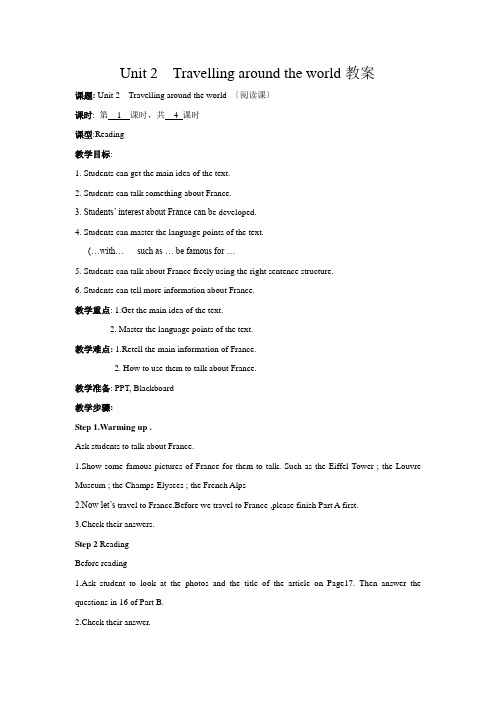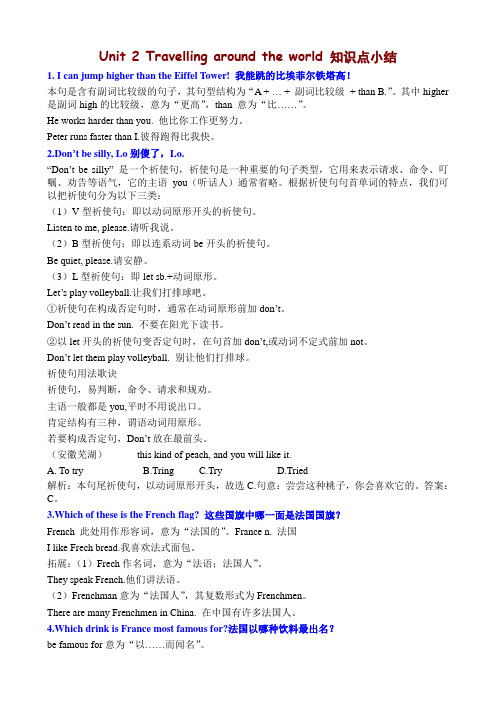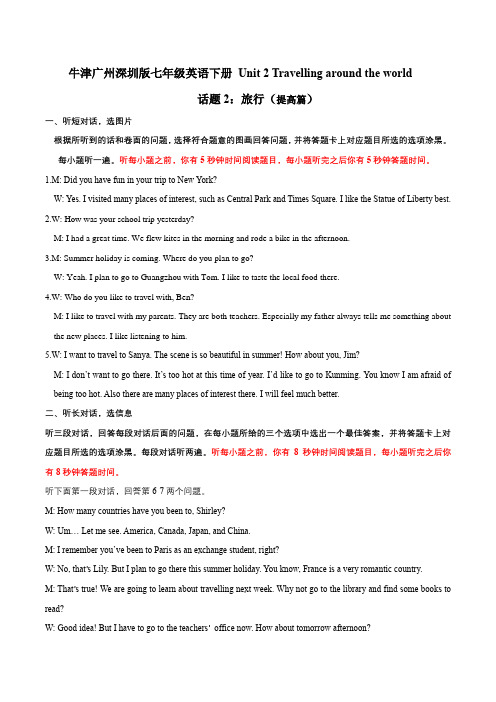牛津深圳版七年级下英语Unit2 Travelling around the world教案
- 格式:doc
- 大小:41.00 KB
- 文档页数:8

Unit 2 Travelling around the world教案课题: Unit 2 Travelling around the world 〔阅读课〕课时: 第 1 课时,共 4 课时课型:Reading教学目标:1. Students can get the main idea of the text.2. Students can talk something about France.3. Students’ interest about France can b e developed.4. Students can master the language points of the text.(…with… such as … be famous for …5. Students can talk about France freely using the right sentence structure.6. Students can tell more information about France.教学重点: 1.Get the main idea of the text.2. Master the language points of the text.教学难点: 1.Retell the main information of France.2. How to use them to talk about France.教学准备: PPT, Blackboard教学步骤:Step 1.Warming up .Ask students to talk about France.1.Show some famous pictures of France for them to talk. Such as the Eiffel Tower ;the Louvre Museum ;the Champs-Elysees ;the French Alps2.Now let’s travel to France.Before we travel to France ,please finish Part A first.3.Check their answers.Step 2 ReadingBefore reading1.Ask student to look at the photos and the title of the article on Page17. Then answer the questions in 16 of Part B.2.Check their answer.3.Show the structure of the article for them.While reading1.Read Paragraph 1 and 2 to fill in the form. Check their answers.2. Read Paragraph 3 and 4 to answer some questions.Then check their answers.Post-readingFinish D2 after read the article.Then check their answers.Step 3 RetellingRetell the text, according to the key words(group work) .1. Practice retelling the text one by one in groups.2. Help them to review the key sentences or words and encourage them to retell the text. Step4 Reading comprehension.Read the passage and finish C1;C2;D2;D3(check the answers in groups)Step 5 Language points. Self- study.①Read the text to find the important sentences .②Learn the learning sheet to finish the related exercise .③Group work to share the learning result and help to solve the different points.④show the learning result by groups.Step 6 Using the language points.(games :lucky member)Step 7 DiscussionSolve the problems given by the teacher to earn marks for their group.Step8 Sum upSummarize the language points and group work resultStep9 HomeworkStep 10 The blackboard designbe famous for 以…闻名by the sea 在海边prefer to 更喜欢why not +动词原形=why don’t you +动词原形?为何不做某事?课题: Unit 2 Travelling around the world 〔听说课〕课时:第 2 课时,共 4 课时课型: Listening & Speaking教学目标:1. Students can listen to figure out the key words to finish the passage2. Students can talk about their holiday plan.3. The interest of listening and speaking is developed.教学重点: Listening material about he Eiffel Tower.教学难点: Talk about the plans.教学准备: PPT, Blackboard教学步骤:Step1.Lead in .Enjoy the picture of the Eiffel Tower and talk about it .Step 2 Listening.Material about the Eiffel Tower.before listeningRead to guess the required information(numbers people and why..) .While listeningListen to tape and finish the notes.After listeningAct to be a reporter to report the Eiffel Tower.Step3 Speaking1.Talk about holiday plans (Task –learning )①Discuss to list the questions and answers about holiday plans in groups .②show the dialogue about holiday plans in pairs.1〕Ask students to read after the teacher or the tape.2) Ask some students to read them aloud.Step 4 Games competitionMy holiday plansTalk about m y holiday plans according to the picture. (I would like to go… Because I’d liketo…)Step 5: Writing1. Write out your favorite holiday plan.2. Encourage them to write out their plan by some hints.Step 6 HomeworkStep 7 The blackboard designUnit 2 Travelling around the world2.take the lift 乘坐电梯3.go shopping 去购物go sightseeing 去观光4. 音标课题: Unit 2 Travelling around the world (写作课)课时: 第 3 课时,共 4 课时课型: Writing教学目标:1.The students can use the proper expressions to describe a place.2.Their love of traveling around the world would be developed. 教学重点: Teach them the ways to write about a famous place.教学难点: Using the proper words and structures to describe a place. 教学准备: PPT, Blackboard教学步骤:Step1Warming upStep2 Reading1.Reading: the leaning tower of Pisa. P26.2.Introduce something about the leaning tower using some pictures.3.Read the article and answer the questions.4.Check their answers.Step2: writing1.Before writing: Ask students to think about1)What does a postcard include?2) How to write a postcard.2.While writing: Imitating.PartB You are a holiday. Write a postcard to a friend at home.1.Choose your favorite place of interest to describe.2.Help them to choose and describe their favorite place. Write their expressions and sentencestructures on the BB. Questions to help: Where, what, why…1〕Lead them to write about their place using the proper Language and structure.2〕Write the composition in 3 paragraphs. Where, what, why. Imitating the words and expressions on the BB.3〕Lead them to write about their place using the proper Language and structure.3.After writing: Check with each other.1〕Teach them how to evaluate a writing.2〕exchange the writing in pairs to give remarks to each other .Step3 .Culture corner—BackpackingWork in groups to talk about Backpacking.Step 4 Project1.Ask students to work in groups to finish PartA then check their answers.2.Ask each group to choose a city from A and do some reach about it.3.PartC.Ask some groups to introduce the city to the class.Step5 DevelopmentHelp them to develop their work in words, sentence and structure.Step 6HomeworkRefer to P25 to write a postcard to your friend if you are traveling in your favorite place.Step7 The blackboard designUnit 2 Travelling around the world1.明信片的构成及写法。

Unit 2 Travelling around the worldⅠ. 短语(词组)1.travel around the world 环游世界2.be famous for 因…著/闻名be famous as 作为....而著名3.the capital of France/China 法国/中国的首都4.place of interest 名胜5.such as=for example 例如6.the most famous 最有名的7.want to do sth 想要would like to do sth.8.in the centre of 在…中心9.lie on the coast 坐落在岸边10.summer/winter holiday 暑/寒假11.prefer to do sth. 更喜欢做某事12.try doing sth. 尝试着做某事try to do sth. 试图/尽力做某事13.ski on the mountains 在山上滑雪14.go skiing 去滑雪15.why not do sth…/why don’t you +do sth ? 为什么不...16.In the east/west/south/north (在内部)on the east/west/south/north 外部接壤to the east/west/south/north 外部不接壤17.learn about 学习,了解18.be different from 与…不同be the same as 与…相同be similar to 与...类似Ⅱ. 语法:专有名词& and /but /so一.专有名词(一)人名例如:Mary Smith;George Washington。
(二)地名(1)大部分单数形式的地名不用定冠词。
例如:Asia;America;China;London;Shanghai (2)大部分单数形式的湖、岛、山名前不加定冠词。

Unit 2 Travelling around the world 知识点小结1. I can jump higher than the Eiffel Tower! 我能跳的比埃菲尔铁塔高!本句是含有副词比较级的句子,其句型结构为“A + … + 副词比较级+ than B.”。
其中higher 是副词high的比较级,意为“更高”,than 意为“比……”。
He works harder than you. 他比你工作更努力。
Peter runs faster than I.彼得跑得比我快。
2.Don’t be silly, Lo别傻了,Lo.“Don’t be silly”是一个祈使句,祈使句是一种重要的句子类型,它用来表示请求、命令、叮嘱、劝告等语气,它的主语you(听话人)通常省略。
根据祈使句句首单词的特点,我们可以把祈使句分为以下三类:(1)V型祈使句:即以动词原形开头的祈使句。
Listen to me, please.请听我说。
(2)B型祈使句:即以连系动词be开头的祈使句。
Be quiet, please.请安静。
(3)L型祈使句:即let sb.+动词原形。
Let’s play volleyball.让我们打排球吧。
①祈使句在构成否定句时,通常在动词原形前加don’t。
Don’t read in the sun. 不要在阳光下读书。
②以let开头的祈使句变否定句时,在句首加don’t,或动词不定式前加not。
Don’t let them play volleyball. 别让他们打排球。
祈使句用法歌诀祈使句,易判断,命令、请求和规劝。
主语一般都是you,平时不用说出口。
肯定结构有三种,谓语动词用原形。
若要构成否定句,Don’t放在最前头。
(安徽芜湖)______this kind of peach, and you will like it.A. To tryB.TringC.TryD.Tried解析:本句尾祈使句,以动词原形开头,故选C.句意:尝尝这种桃子,你会喜欢它的。

Unit 2 Travelling around the world单元测试题(牛津深圳版七年级下) I.词汇:根据汉语或首字母提示写单词,补全句子。
(共10小题,每小题0。
5分) 1。
I think it's _______(可能的) for you to get first prize in the contest.2. You cannot drive cars after you drink w______.3。
The 2010 Asian Games were held near Guangzhou________(塔)4。
As students, you should study hard and f_______ your homework on time。
5. From the a _______ in the letter, I know where she lives.6. To get to the 20th floor of this building, you must take a l________。
7。
The Pearl River l______ in the city of Guangzhou。
8。
I want to go to the_______(海岸)and take some photos there.9。
I'm looking forward to going to_________(法国)。
10. Practice makes ________ (完美)。
II.句子:根据汉语提示,补全句子.每空一词。
(共5小题,每小题2分)11。
由于山坡积雪,我们不得不.小心翼翼地向上走。
As the hillside was covered with snow, we had to _______ ______ carefully.12。
在市中心有很多百货商店.There are many______ _____ in the center of the city13.这些年来人们的环境意识增强了.Environmental awareness has increased_______ ______ _______。

U2 travelling around the world Self-Assessment and Project导学案每日分享:分享:An hour in the morning is worth tw o in the evening. 一日之计在于晨。
课题教学目标语言知识复习第二单元各部分知识。
语言技能利用本单元所学内容,通过小组合作介绍一座城市的概况和旅游信息情感态度加深对世界上主要的大城市的了解,培养对异国文化的兴趣。
教学重点复习第二单元各部分知识教学难点利用本单元所学内容,通过小组合作介绍一座城市的概况和旅游信息。
学习过程一、温故知新(复习第二单元各部分知识可用课件):①The article France is calling1. “France is in ____ Europe. It is a country ____many beautiful pl aces.”2. Paris is the ____ of France.3. The ____famous street in Paris is the Champs-Elysees.4. The south of France ____on the coast, and it is ____ ____ its wonderful beaches.5. A French town ____the sea is the perfect place ____a summer holiday。
6. But if you ____to visit France in winter, you can try ____on the mountains in the French Alps.7. France has something for everyone, so____ ____visit France this year?”用上面的句子提示复述课文②Listening The Eiffel Tower总结介绍景点的常用方法③Grammar Proper nounsWe use a proper noun to refer to the name of a particu lar person, place, organization or time.A proper noun starts with a capital letter.④Conjunctions: and, but & soWe use ______ to mean “also”.We use ______ to show a different idea.We use ______ to show a result.⑤Sounds/ts/and/dz/ /tr/and/dr/ /ts/ and /dz/.⑥Talk about a holiday plan:A. What nameB. WhereC. What is it famous for?D. Why?E. Others⑦Write a postcard16 MarchDear Mabel,Hello. We (1) ______ last week by bus. We(2) _____ at the camp in the picture. It is at the bottom of Mount Kinabalu.We (3) _________ the mountain tomorrow. Best wishes,Peter Mabel JonesRoom 20XX, 20/F Building 2 Garden House Shanghai 20XX00P.R. China⑧BackpackingRet ell Backpacking二、探究学习1.In group, write down the names of the cities of the capital city and the largest city in eachcountry in the table on p28.2.Choose a city and make a travel brochure.·Wha t goes in a travel brochure?•Which part of the countr y is the city in?•How big is it? How large is its population?•What interesting places can you visit in this city?三. 拓展练习Come and introduce the city you are from!Use the knowledge of this unit to write an article.____________ (your own city) is calling总结反思:通过本节课的学习我最大的收获:_______________________________________ 感到自己有待加强的是:_______________________________________________教师的职务是‘千教万教,教人求真’;学生的职务是‘千学万学,学做真人’。

牛津广州深圳版七年级英语下册Unit 2 Travelling around the world话题2:旅行(提高篇)一、听短对话,选图片根据所听到的话和卷面的问题,选择符合题意的图画回答问题,并将答题卡上对应题目所选的选项涂黑。
每小题听一遍。
听每小题之前,你有5秒钟时间阅读题目,每小题听完之后你有5秒钟答题时间。
1.M: Did you have fun in your trip to New York?W: Yes. I visited many places of interest, such as Central Park and Times Square. I like the Statue of Liberty best.2.W: How was your school trip yesterday?M: I had a great time. We flew kites in the morning and rode a bike in the afternoon.3.M: Summer holiday is coming. Where do you plan to go?W: Yeah. I plan to go to Guangzhou with Tom. I like to taste the local food there.4.W: Who do you like to travel with, Ben?M: I like to travel with my parents. They are both teachers. Especially my father always tells me something about the new places. I like listening to him.5.W: I want to travel to Sanya. The scene is so beautiful in summer! How about you, Jim?M: I don’t want to go there. It’s too hot at this time of year. I’d like to go to Kunming. You know I am afraid of being too hot. Also there are many places of interest there. I will feel much better.二、听长对话,选信息听三段对话,回答每段对话后面的问题,在每小题所给的三个选项中选出一个最佳答案,并将答题卡上对应题目所选的选项涂黑。
Unit 2 Travelling around the world 知识点小结1. I can jump higher than the Eiffel Tower! 我能跳的比埃菲尔铁塔高!本句是含有副词比较级的句子,其句型结构为“A + … + 副词比较级+ than B.”。
其中higher 是副词high的比较级,意为“更高”,than 意为“比……”。
He works harder than you. 他比你工作更努力。
Peter runs faster than I.彼得跑得比我快。
’t be silly, Lo别傻了,Lo.“Don’t be silly”是一个祈使句,祈使句是一种重要的句子类型,它用来表示请求、命令、叮嘱、劝告等语气,它的主语you(听话人)通常省略。
根据祈使句句首单词的特点,我们可以把祈使句分为以下三类:(1)V型祈使句:即以动词原形开头的祈使句。
Listen to me, please.请听我说。
(2)B型祈使句:即以连系动词be开头的祈使句。
Be quiet, please.请安静。
(3)L型祈使句:即let sb.+动词原形。
Let’s play volleyball.让我们打排球吧。
①祈使句在构成否定句时,通常在动词原形前加don’t。
Don’t read in the sun. 不要在阳光下读书。
②以let开头的祈使句变否定句时,在句首加don’t,或动词不定式前加not。
Don’t let them play volleyball. 别让他们打排球。
祈使句用法歌诀祈使句,易判断,命令、请求和规劝。
主语一般都是you,平时不用说出口。
肯定结构有三种,谓语动词用原形。
若要构成否定句,Don’t放在最前头。
(安徽芜湖)______this kind of peach, and you will like it.A. To try解析:本句尾祈使句,以动词原形开头,故选C.句意:尝尝这种桃子,你会喜欢它的。
牛津深圳版七年级下英语Unit 2 Travelling around the world教案课题: Unit 2 Travelling around the world (阅读课)课时: 第 1 课时,共 4 课时课型:Reading教学目标:1. Students can get the main idea of the text.2. Students can talk something about France.3. Students’ interest about France can be developed.4. Students can master the language points of the text.(…with… such as … be famous for …5. Students can talk about France freely using the right sentence structure.6. Students can tell more information about France.教学重点: 1.Get the main idea of the text.2. Master the language points of the text.教学难点: 1.Retell the main information of France.2. How to use them to talk about France.教学准备: PPT, Blackboard教学步骤:Step 1.Warming up .Ask students to talk about France.1.Show some famous pictures of France for them to talk. Such as the Eiffel Tower ;the Louvre Museum ;the Champs-Elysees ;the French Alps2.Now let’s travel to France.Before we travel to France ,please finish Part A first.3.Check their answers.Step 2 ReadingBefore reading1.Ask student to look at the photos and the title of the article on Page17. Then answer the questions in 16 of Part B.2.Check their answer.3.Show the structure of the article for them.While reading1.Read Paragraph 1 and 2 to fill in the form. Check their answers.2. Read Paragraph 3 and 4 to answer some questions.Then check their answers.Post-readingFinish D2 after read the article.Then check their answers.Step 3 RetellingRetell the text, according to the key words(group work) .1. Practice retelling the text one by one in groups.2. Help them to review the key sentences or words and encourage them to retell the text. Step4 Reading comprehension.Read the passage and finish C1;C2;D2;D3(check the answers in groups)Step 5 Language points. Self- study.①Read the text to find the important sentences .②Learn the learning sheet to finish the related exercise .③Group work to share the learning result and help to solve the different points.④show the learning result by groups.Step 6 Using the language points.(games :lucky member)Step 7 DiscussionSolve the problems given by the teacher to earn marks for their group.Step8 Sum upSummarize the language points and group work resultStep9 HomeworkStep 10 The blackboard designbe famous for 以…闻名by the sea 在海边prefer to 更喜欢why not +动词原形=why don’t you +动词原形?为何不做某事?课题: Unit 2 Travelling around the world (听说课)课时:第 2 课时,共 4 课时课型: Listening & Speaking教学目标:1. Students can listen to figure out the key words to finish the passage2. Students can talk about their holiday plan.3. The interest of listening and speaking is developed.教学重点: Listening material about he Eiffel Tower.教学难点: Talk about the plans.教学准备: PPT, Blackboard教学步骤:Step1.Lead in .Enjoy the picture of the Eiffel Tower and talk about it .Step 2 Listening.Material about the Eiffel Tower.before listeningRead to guess the required information(numbers people and why..) . While listeningListen to tape and finish the notes.After listeningAct to be a reporter to report the Eiffel Tower.Step3 Speaking1.Talk about holiday plans (Task –learning )①Discuss to list the questions and answers about holiday plans in groups .②show the dialogue about holiday plans in pairs.2.继续学习音标1)Ask students to read after the teacher or the tape.2) Ask some students to read them aloud.Step 4 Games competitionMy holiday plansTalk about m y holiday plans according to the picture. (I would like to go… Because I’d like to…)Step 5: Writing1. Write out your favorite holiday plan.2. Encourage them to write out their plan by some hints.Step 6 HomeworkStep 7 The blackboard designUnit 2 Travelling around the world1.基数词的读法2.take the lift 乘坐电梯3.go shopping 去购物go sightseeing 去观光4. 音标课题: Unit 2 Travelling around the world (写作课)课时: 第 3 课时,共 4 课时课型: Writing教学目标:1.The students can use the proper expressions to describe a place.2.Their love of traveling around the world would be developed.教学重点: Teach them the ways to write about a famous place.教学难点: Using the proper words and structures to describe a place.教学准备: PPT, Blackboard教学步骤:Step1Warming upStep2 Reading1.Reading: the leaning tower of Pisa. P26.2.Introduce something about the leaning tower using some pictures.3.Read the article and answer the questions.4.Check their answers.Step2: writing1.Before writing: Ask students to think about1)What does a postcard include?2) How to write a postcard.2.While writing: Imitating.PartB You are a holiday. Write a postcard to a friend at home.1.Choose your favorite place of interest to describe.2.Help them to choose and describe their favorite place. Write their expressions and sentencestructures on the BB. Questions to help: Where, what, why…1)Lead them to write about their place using the proper Language and structure.2)Write the composition in 3 paragraphs. Where, what, why. Imitating the words and expressions on the BB.3)Lead them to write about their place using the proper Language and structure.3.After writing: Check with each other.1)Teach them how to evaluate a writing.2)exchange the writing in pairs to give remarks to each other .Step3 .Culture corner—BackpackingWork in groups to talk about Backpacking.Step 4 Project1.Ask students to work in groups to finish PartA then check their answers.2.Ask each group to choose a city from A and do some reach about it.3.PartC.Ask some groups to introduce the city to the class.Step5 DevelopmentHelp them to develop their work in words, sentence and structure.Step 6HomeworkRefer to P25 to write a postcard to your friend if you are traveling in your favorite place.Step7 The blackboard designUnit 2 Travelling around the world1.明信片的构成及写法。